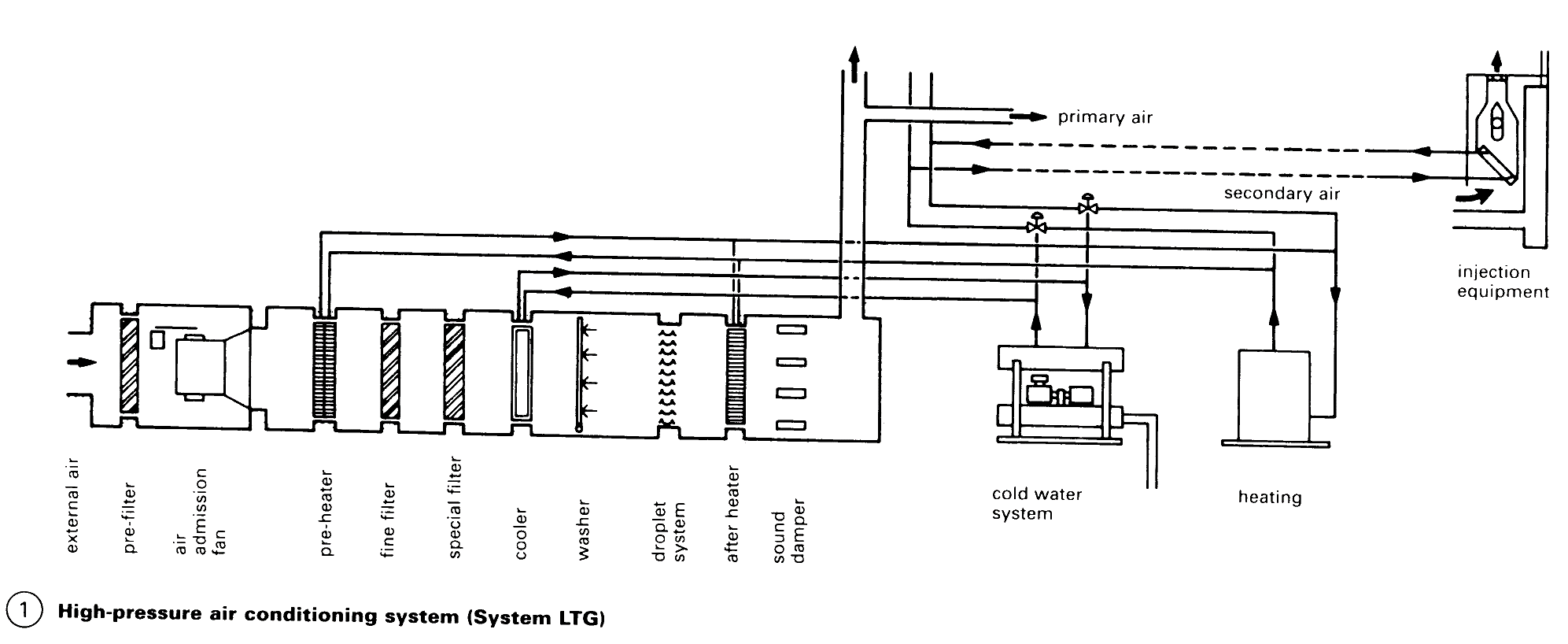High-pressure Air Conditioning Systems. Air Conditioning Convectors
To meet the demand for heat in winter and cooling in summer, large cross-sections of low-pressure air conditioning systems are needed - it is not for ventilation. High-pressure air conditioning systems require only approx. 1/з of the usual air quantities; they use external air for ventilation while transporting heat and cold through water pipes (1 m3 of water can transport approx. 3450 times more heat than 1m3 of air).
An air conditioning convector unit (with special air outlet jets and a heat exchanger) installed under every window is supplied with conditioned air and cooled or heated water. Regulation takes place only at the heat exchanger. Smaller quantities of air enable smaller control rooms to be used and with acceptable air conditioning. The external air is cleaned using a pre-filter and a fine filter. The whole building is at a slight positive pressure with respect to the outside, so that any air gaps in the building fabric have virtually no effect.
Air conditioning convectors. General requirements: noise intensity < 30-33phon; air filter for cleaning the secondary air; heat exchanger must be able to ensure full heating to room temperature in any weather, even without the ventilation air system; cold water temperature in summer must be 15-16°C, or the cooling operation will be uneconomical and condensation will form on window systems (soiling of cooling surfaces). For ideal flow conditions without vibration, high-pressure air ductwork should be of round section where possible.
With a vertical arrangement of supply lines and window spacings of 1.5-2m, alternate the structural columns with vertical service ducts containing the air ductwork and water pipes. Rising air ductwork for buildings with 7 storeys are 175-255mm diameter. For taller buildings, separate supplies lines are needed for each 7-10 storeys and a storey devoted to the installation of heating and ventilation plant. A more expensive arrangement involves a main air shaft, with horizontal distribution along the corridors and branching ductwork directed outwards into the ceiling voids above rooms, to terminate directly behind the facade above the windows, or, at floor level, in the rooms above through holes in the floor structure.
Max. office depth for high- pressure installations: 6m, beyond which air cooling requires an additional central conditioning system. Max. building depth without a central system: (2x6=) 12 m plus the corridor. Air can be removed through ducts over corridor wall storage cupboards or in ducting above the corridors and through WCs. In high-pressure systems, air is not recirculated (the air mass has already been reduced to that required for acceptable ventilation). For limited operation, the primary air flow can be reduced in the plant room.

Ventilation systems for kitchens. For large kitchens (height 3-5m), render the upper sections (walls and ceilings) in porous plaster (no oil painting); provide 15-30 air changes, pressure below atmospheric, creating air flow from adjacent rooms into the kitchen; use larger radiators as appropriate; group boilers, cookers and fryers together; provide air extraction with a fat filter; clean ducting annually; filter and heat the air inlet flow in winter. No air circulation system is needed; local heating and insulating glazing are needed.
Date added: 2023-01-05; views: 568;
